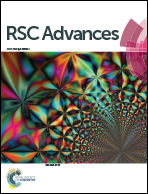Graphene based nanoassembly for simultaneous detection and degradation of harmful organic contaminants from aqueous solution†
Abstract
Graphene based nanoassemblies that can simultaneously detect and degrade harmful organic contaminants from water are important for conquering the risk of hazardous chemicals. A unique semiconductor–metal–graphene nanosheet assembly design has been successfully fabricated by a wet chemical method. Such a nanoassembly arrangement is made up of ZnO–Ag core–shell nanostructures and integrates on graphene nanosheets (GNSs). High-resolution scanning transmission electron microscopy reveals that ZnO–Ag core–shell nanostructures consist of a core ZnO nanosphere covered by a Ag shell and are chemically decorated on the GNS surface. This ZnO–Ag–GNS nanoassembly is SERS active and hence able to sense organic contaminants such as acridine orange dye. The sunlight-driven photocatalytic activity of the ZnO–Ag–GNS nanoassembly design demonstrates the tremendous enhancement in the detection and degradation of organic contaminants. The results in the present study show that the enhancement in the photocatalytic activity is attributed to the interfacial charge transfer effect in ZnO–Ag–GNS interfaces. This new design exhibits an efficient photocatalytic degradation of organic dye under sunlight irradiation. This could have great potential for a high sensing, stable and reusable material for energy and environmental cleaning applications.


 Please wait while we load your content...
Please wait while we load your content...